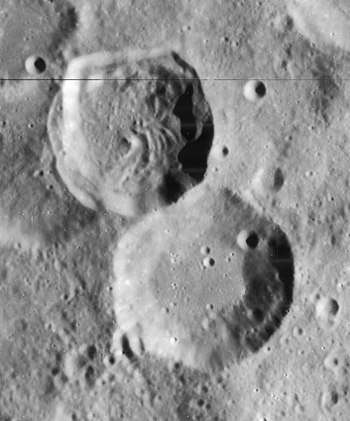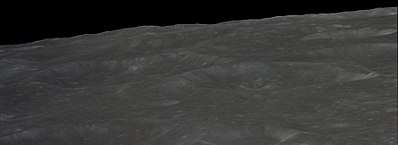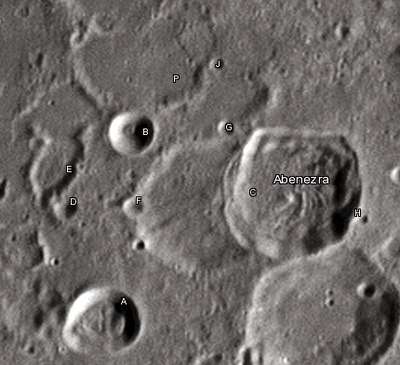Abenezra (crater)
 Lunar Orbiter 4 image of Abenezra crater (upper left) and Azophi crater (lower right) | |
| Coordinates | 21°00′S 11°54′E / 21.0°S 11.9°ECoordinates: 21°00′S 11°54′E / 21.0°S 11.9°E |
|---|---|
| Diameter | 42 km |
| Depth | 3.7 km |
| Colongitude | 349° at sunrise |
| Eponym | Abraham ibn Ezra |

Abenezra is a lunar impact crater located in the rugged highlands in the south-central section of the Moon. It is attached along the southeast rim to the crater Azophi. To the northeast lies the crater Geber, and further to the southeast is the larger Sacrobosco.
The rim of Abenezra has a noticeably polygonal shape, with uneven wall segments. The inner walls are terraced, and the floor is irregular and ridged. These ridges form unusual, sinuous patterns across the floor. The crater overlays the eastern part of another crater-like formation designated Abenezra C.
Names
Abenezra is named after the Sephardic Jewish sage, poet, biblical commentator, astronomer, and astrologer Abraham ibn Ezra, it was given its name by Giovanni Riccioli, whose 1651 nomenclature system has become standardized.[1][2] Earlier lunar cartographers had given the feature different names. Michael van Langren's 1645 map calls it "Schyrlei" after Anton Maria Schyrleus of Rheita,[1] his map were map slightly apart from the other crater which he called "Mersenni", now Azophi[3] The crater named after Anton Maria Schyrleus of Rheita would be later named a crater to the southeast as Rheita, located near Metius, named by Riccioli and later a valley known as Vallis Rheita. The 1647 map by Johannes Hevelius grouped it with Azophi and Geber and called it "Antitaurus" after the mountains of the ancient world.[1][4]
Satellite craters

By convention these features are identified on lunar maps by placing the letter on the side of the crater midpoint that is closest to Abenezra.
| Abenezra | Latitude | Longitude | Diameter |
|---|---|---|---|
| A | 22.8° S | 10.5° E | 23 km |
| B | 20.8° S | 10.1° E | 14 km |
| C | 21.3° S | 11.1° E | 44 km |
| D | 21.7° S | 9.7° E | 8 km |
| E | 21.4° S | 9.4° E | 14 km |
| F | 21.5° S | 10.3° E | 7 km |
| G | 20.5° S | 11.0° E | 5 km |
| H | 21.1° S | 12.8° E | 4 km |
| J | 19.9° S | 10.7° E | 5 km |
| P | 19.9° S | 9.9° E | 44 km |
Notes
- 1 2 3 Ewen A. Whitaker, Mapping and Naming the Moon (Cambridge University Press, 1999).
- ↑ Riccioli map of the Moon (1651)
- ↑ Langrenus map of the Moon (1645)
- ↑ Hevelius map of the Moon (1647)
References
- Andersson, L. E.; Whitaker, E. A. (1982). NASA Catalogue of Lunar Nomenclature. NASA RP-1097.
- Blue, Jennifer (July 25, 2007). "Gazetteer of Planetary Nomenclature". USGS. Retrieved 2007-08-05.
- Bussey, B.; Spudis, P. (2004). The Clementine Atlas of the Moon. New York: Cambridge University Press. ISBN 978-0-521-81528-4.
- Cocks, Elijah E.; Cocks, Josiah C. (1995). Who's Who on the Moon: A Biographical Dictionary of Lunar Nomenclature. Tudor Publishers. ISBN 978-0-936389-27-1.
- McDowell, Jonathan (July 15, 2007). "Lunar Nomenclature". Jonathan's Space Report. Retrieved 2007-10-24.
- Menzel, D. H.; Minnaert, M.; Levin, B.; Dollfus, A.; Bell, B. (1971). "Report on Lunar Nomenclature by the Working Group of Commission 17 of the IAU". Space Science Reviews. 12 (2): 136–186. Bibcode:1971SSRv...12..136M. doi:10.1007/BF00171763.
- Moore, Patrick (2001). On the Moon. Sterling Publishing Co. ISBN 978-0-304-35469-6.
- Price, Fred W. (1988). The Moon Observer's Handbook. Cambridge University Press. ISBN 978-0-521-33500-3.
- Rükl, Antonín (1990). Atlas of the Moon. Kalmbach Books. ISBN 978-0-913135-17-4.
- Webb, Rev. T. W. (1962). Celestial Objects for Common Telescopes (6th revised ed.). Dover. ISBN 978-0-486-20917-3.
- Whitaker, Ewen A. (1999). Mapping and Naming the Moon. Cambridge University Press. ISBN 978-0-521-62248-6.
- Wlasuk, Peter T. (2000). Observing the Moon. Springer. ISBN 978-1-85233-193-1.
External links
| Wikimedia Commons has media related to Abenezra (crater). |
Related articles
- Wood, Chuck (January 5, 2007). "Sacreblue?, No, Sacrobosco". Lunar Photo of the Day. Archived from the original on November 3, 2017.
